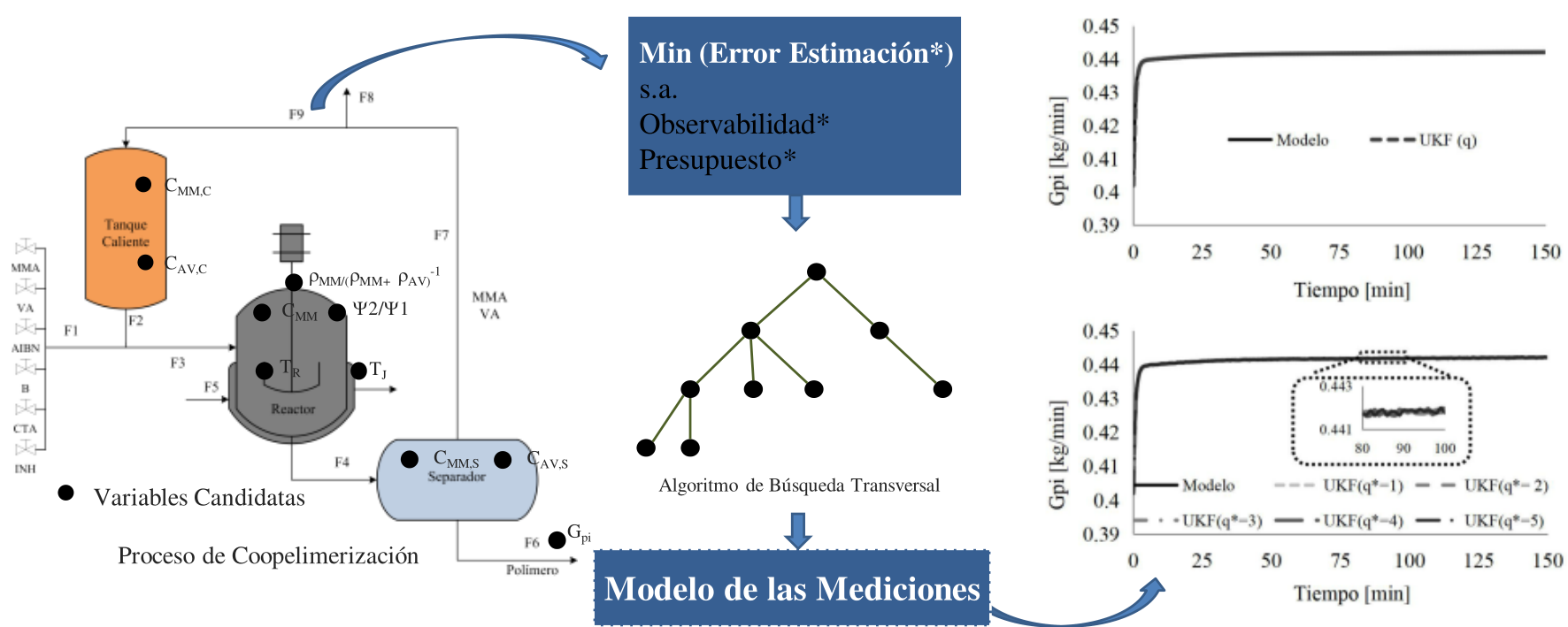Sensor Network Design based on the Observability and Precision degree
Keywords:
Copolymerization Process, Level Traversal Search, Observability and Precision degree, Sensor Network Design, Unscented Kalman FilterAbstract
The Unscented Kalman Filter is a state estimation method used in nonlinear dynamic systems to estimate the mean and covariance of a random variable undergoing a nonlinear transformation, knowing the process model and the measurements. Therefore, an adequate choice of the measured variables improves the performance of the filter technique. In this context, the sensor network design problem allows selecting a set of variables that minimizes the global estimation error when the instrumentation budget is limited. This is solved using a level traversal tree search algorithm, whose computation time is reduced by evaluating the design criteria sequentially. In this work, it is proposed to address the effect of the circumstantial loss of measurements on the system observability and the estimates precision. The success of the sensor network design methodology is demonstrated for the copolymerization process of Methyl Methacrylate and Vinyl Acetate, widely studied in the literature.
Downloads
References
S. Julier, J. Uhlmann, H. F. Durrant-Whyte, (2000). "A new method for the nonlinear transformation of means and covariances in filters and estimators” IEEE Trans. Autom. Control 45 (3) 477–482.
M. Mallick, X. Tian, J. Liu, (2021) Evaluation of Measurement Converted KF, EKF, UKF, CKF, and PF in GMTI Filtering, 2021 International Conference on Control, Automation and Information Sciences (ICCAIS), 21-27.
J. A. Romagnoli, M. C. Sánchez, “Data Processing and Reconciliation for Chemical Process Operations” Elsevier. 1999
M. Bhushan, R. Rengaswamy, (2002) "Comprehensive design of a sensornetwork for chemical plants based on various diagnosability andreliability criteria. 1. Framework". Ind. Eng. Chem. Res. 41, 1826-1832.
L. Rodriguez, J. Tupaz, M. Sánchez, (2021) “Sensor location for nonlinear state estimation”, J. Process Control, 100, 11-19
M. Bagajewicz, “Design and Upgrade of Process Plant Instrumentation” Technomic Publishing Company, PA, 2000
P. Mobed, J. Maddala, P. Pednekar, D. Bhattacharyya, R. Rengaswamy (2015) “Optimal Sensor Placement for Fault Diagnosis Using Magnitude Ratio.” Ind. Eng. Chem. Res. 54 (38), 9369-9381
O. Prakash, M. Bhushan, S. Narasimhan, R. Rengaswamy, (2020) “Sensor network design based on system-wide reliability criteria. Part I: Objectives.” J. Process Control. 93, 7, 66-82
O. Prakash, M. Bhushan, S. Narasimhan, R. Rengaswamy, (2020) “Sensor network design based on system-wide reliability criteria. Part II: Formulations and applications.” J. Process Control. 93, 5, 14-27
M. Bagajewicz, M. Sánchez, (2000) “Cost-optimal design of reliable sensor networks”, Computers and Chemical Engineering, 23, (11–12), 1757-1762
M. Carnero, J. Hernández, M. Sánchez, (2018) “Optimal Sensor Location in Chemical Plants Using the Estimation of Distribution Algorithms.”Ind. Eng. Chem. Res. 57 (36), 12149-12164
E. Musulin, C. Benqlilou, M. J. Bagajewicz, L. Puigjaner, (2005) “Instrumentation design based on optimal Kalman filtering” J. Process Control 15 (6) 629–638
A. K. Singh, J. Hahn, (2005) “Determining Optimal Sensor Locations for State and Parameter Estimation for Stable Nonlinear Systems”, Ind. Eng. Chem. Res. 44, 5645-5659
A. K. Singh, J. Hahn, (2006). “Sensor location for stable nonlinear dynamic systems: multiple sensor case”, Ind. Eng. Chem. Res. 45 3615–3623
V. Mohammadnia, K. A. Salahshoor, (2012). “New comprehensive sensor network design methodology for complex nonlinear process plants”, Iranian J. Chem. Eng. 31 (3) 145–156
P. Paul, D. Bhattacharyya, R. Turton, S. E. Zitney, (2017), “Nonlinear dynamic model based multi objective sensor network design algorithm for a plant with an estimator-based control system”, Ind. Eng. Chem. Res. 56 (26) 7478–7490.
M. A. Jarinah, H. Hoang, M. A. Hussain, D. Dochain, (2015) “Review and classification of recent observers applied in chemical process systems”, Comput. Chem. Eng. 76, 27–41.
D. Nguyen, M. J. Bagajewicz, (2011). “New efficient breadth-first/level traversal treesearch method for the design and upgrade of sensor networks”, AIChE J. 57(5) 1302–13029
R. Galdeano, M. Astesuain, M. Sánchez, (2011) “Unscented transformation based filters: Performance comparison analysis for the state estimation in polymerization processes with delayed measurements”, Macromol. React. Eng. 5 (7–8) 278–293.
B. A. Ogunnaike, W. H. Ray, (1994) “Process Dynamics, Modeling and Control”, Oxford University Press, Oxford, UK
S. D. Salas y otros (2018). “Framework design for weight-average molecular weight control in semi-batch polymerization” Control Eng. Pract. 78, 12–23


